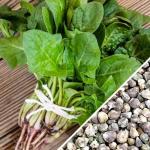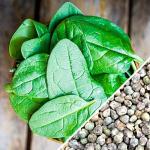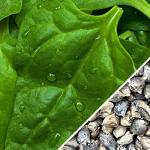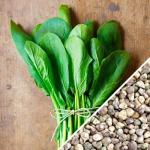Why you should be growing your own spinach instead of buying from the grocery store or big-box retailer:
If you follow EWG’s 2019 Shopper’s Guide to Pesticides in Produce™ report that comes out around March every year, you’ve probably heard that conventionally grown spinach has more pesticide residues by weight than all other produce tested, with three-fourths of samples tested contaminated with a neurotoxic bug killer banned from use on food crops in Europe. It has moved from being ranked 8th on EWG’s “Dirty Dozen” list to number two in containing the most pesticides in fruits and vegetables presently being sold in supermarkets and grocery stores around the United States. The USDA has also detected pesticides on frozen and canned spinach, which suggests that washing and cooking reduces, but does not eliminate pesticide levels. (You can read the full findings on spinach in a press release here.)
As you may already be aware, Spinach is a great source of vitamin A, folate and vitamin C and a good source of vitamin E and potassium. But for your body to receive all these nutritional benefits, it is essential to consume the spinach as quickly as possible following harvest. Baby spinach leaves have a very high respiration rate and studies have shown that the temp these leaves are stored at plays a key role. For example, one Hort Technology study found that Baby spinach leaves (harvested 36 days after planting) experienced significant losses in nutritional benefit. Both total antioxidant activities and Vitamin C content showed a decrease after 6 days when stored at 39.2°F, whereas the total antioxidant activities and vitamin C for leaves stored at 71.6ºF decreased immediately after 2 days. The concentration of magnesium (Mg), zinc (Zn), and iron (Fe) for example, declined after 8 days of storage at 39.2ºF, while at 71.6ºF they declined after 2 days of storage. Total phenolic compounds gradually decreased in samples stored at 39.2ºF whereas, samples stored at 71.6ºF showed a rapid decrease after 4 days. Results demonstrated that quality of baby spinach deteriorates as storage time and temperature increase. (You can read more about the study here.)
Research shows that nutritional benefits degrade with every hour following harvest, so the sooner you can consume your food after it’s been harvested, the more nutrients your body will receive from the spinach.
Degradation happens not only with temperatures, but you also need to factor how long it takes to move the spinach from harvest, transportation, to the product sitting on the shelf to be purchased at the store. It is estimated that it takes about 10-days for produce to be shipped from where it is grown to get to the consumer’s plate. Ten days!!! And you, the consumer are relying heavily on whether or not that spinach was kept at a constant 39.2ºF or lower in the post-harvest transportation and storage process. Could the reason be it is cheap at the store is it is an inferior product compared to what can be grown in your own home?
With a little know-how, you don’t have to settle for sub-par spinach and greens. You can grow in your own home and harvest when you’re ready to consume your spinach and greens for optimal nutritional benefit.
For the purposes of this article, we are writing it with aeroponic / hydroponic Tower Garden by JuicePlus+™ growers in mind for either indoors or outdoors growing spinach in their own home of on a backyard deck, but the info will also work in related hydroponic systems so long as the environment fits the plant’s needs.
Growing your own baby spinach will offer you the peace of mind and gain self-assurance knowing that your home-grown baby spinach is clean. You will also be able to harvest for maximum nutritional benefit when the plant is at it’s peak nutritionally going directly from your Tower Garden to your dinner table in a matter of minutes!
Growing your own spinach:
To grow your spinach, here are some things to keep in mind with what spinach needs to grow successfully. Depending on the time of year and whether you are growing inside or outside are key factors to consider. Spinach is a COOL SEASON crop, so you’ll want to avoid extreme heat which can cause it to bolt (go to seed and become bitter).

Choosing your spinach variety:
Plant from seed making sure that you have new seed as older seed has a greater difficulty in germinating. Those varieties that are most suitable for the Tower Garden are recommended as follows:
Spinach: Monnopa Heirloom Low-Acid Spinach (Very Rare)
(100% Heirloom/Non-Hybrid/Non-GMO buy seed )
- Monnopa Spinach is a perfect choice for those who need low-acid foods in their diet.
– Extremely delicious and one of the most sweetest spinach varieties you can grow in your Tower Garden or hydroponic system
– Very easy to grow. - Days to Maturity | 45-60 days
Spinach: Noble Giant
(100% Heirloom/Non-Hybrid/Non-GMO buy seed )
- Noble Giant Spinach is heavy, glossy, dark green plant with leaves that are heavily savoyed and crumpled.
– Extremely delicious and one of the most popular spinach varieties you can grow in your Tower Garden or hydroponic system
– Very easy to grow. - Days to Maturity | 45 days
Spinach: New Zealand
(100% Heirloom/Non-Hybrid/Non-GMO buy seed )
- New Zealand Spinach seeds will produce very flavorful medium triangular-shaped green spinach leaves. New Zealand Spinach is a large growing plant.
- This is one of the few spinach varieties that produces continuously all year, from spring to fall. The more you cut and use the more it will continue to grow.
- And … Unlike the other spinach varieties, the New Zealand is one that can survive through the hot summers.
- Days to Maturity | 75 days
Spinach: Bloomsdale
(100% Heirloom/Non-Hybrid/Non-GMO buy seed )
- Bloomsdale Spinach will produce heavy, glossy, dark green leaves.
– Excellent flavor
– Extremely easy to grow
– Large, curly dark green leaves
– Nice sweet taste - Days to Maturity | 45 days
Spinach: America
(100% Heirloom/Non-Hybrid/Non-GMO buy seed )

- America Spinach will produce a beautiful dark green plant in only 40 days. Smaller plant stature.
– Excellent flavor.
– Extremely easy to grow.
– Grows best during the cooler months. - Days to Maturity | 40 days
Spinach: Matador Viking
(100% Heirloom/Non-Hybrid/Non-GMO buy seed )
- Matador Viking Spinach will produce beautiful large and smooth dark green spinach leaves in only 45 days.
– Excellent flavor.
– Full of nutrients.
– Extremely easy to grow.
– Grows best during the cooler months.
– Grows really well in containers and other small spaces. - Days to Maturity | 45 days
Spinach: Winter Giant
(100% Heirloom/Non-Hybrid/Non-GMO buy seed )

- Winter Giant Spinach seeds will produce very flavorful large green spinach leaves.
- Winter Giant is a variety of Spinach which is a member of the Spinacia family. It is a Vegetable and is treated mainly as a Annual, this means that it grows best over the course of a single year. source: myfolia
- Known for growing to a height of appx. 2 feet.
- Days to Maturity | 55 days
Choose slow-bolting varieties for later spring plantings. Disease resistance is more important for fall crops. Savoyed (curly) leaves are handsome and keep better. New Zealand spinach and Malabar spinach are warm-season greens similar to spinach, but different species.
Common spinach cannot grow in midsummer. (For a summer harvest, try New Zealand Spinach or Malabar Spinach, two similar leafy greens that are more heat tolerant.) — Old Farmer’s Almanac
If you’re later in the season and have missed your seed start date, you can always purchase spinach starts from an area hydroponic grower. We recommend driving to a local grower to pick-up any seedlings vs. shipping (remember shipping containers can be extremely warm or extremely cold which can damage tender young plants.)
How many plants should you plant:
It is estimated that you will want ideally 15 plants per person. For a family of four, you will want to plant an entire Tower Garden with one extension for 28 plants and keep two spinach plants per rock wool making for 56 plants total.
Starting your spinach from seed:
Cold stratification: One to three-weeks prior to planting some growers will store seeds in the refrigerator. It has the effect of hardening them and may lead to a healthier plant.
If you’re planting outdoors, you’ll want to pay attention to your frost and freeze dates in your area. You can find these dates doing a google search or here. (If planting indoors, you can ignore the next paragraph and skip down to the next paragraph as you can plant spinach any time of the year using the Tower Garden LED Indoor Lights with the assumption that you will keep your home in the temperature range spinach requires.)
Having trouble getting your spinach seed to germinate? Try this pro tip: place seed in a plastic container in between two wetted paper towels and seal by placing lid on top of container. Check your seeds in 7-10 days and if the seed is viable, you will see some seeds with a root breaking out of the seed casing. You’ll want to move this germinated seed into a wet cube of rock wool and place a few bits of vermiculite around the germinated seed to retain moisture. DO NOT place on a heat mat. Place under bright artificial grow lights while keeping rock wool and vermiculite moist, but not drenched/soaked. Make sure to have a fan in the room for air movement as well as this will help to control humidity levels and stave off any fungal disease from setting into you seedlings.
Outdoor planting in a hydroponics system: If planting in the spring, you will want to start your seeds indoors or in a greenhouse so that your seedling start will be about four to six weeks old by the time your spring frost date rolls around. If planting in the fall, you’ll want to factor in your harvest date range and count backwards from your frost date. Note: in the fall, you will want to expose your seedlings to UV rays without excessive heat. Spinach likes to live around 45º-75º and may fail to germinate if too warm. For example, in the southeast, you will want to select a variety that has a short maturation date for a fall planting and use a UV light system of some sort to grow your seedlings indoors keeping the light source 8″-12″ if LEDs and 5″-6″ away from seedlings if fluorescent lighting.

How many seeds to plant per rock wool: We recommend planting about 5 seeds per rock wool cube. Spinach typically germinates within 1–2 weeks. Be sure to use seed that is packaged for the current growing season as it will aide your ability to germinate the seeds. You can always remove any excess seedlings as the plants mature if you are concerned about crowding. Our philosophy is start out with more and thin down as needed (plus the seedlings will be healthy for you to eat as micro-greens).
How much nutrients you should give your seedlings: Water daily with 1/4 strength nutrient solution until the seeds germinate and sprout. After sprouting use 1/2 strength solution.
Thinning out your seedling starts: As the seeds germinate and grow, you will want to pull (or also called “thin out”) the weaker seedlings from the rock wool. (Remember, this is not a wasted plant — you can try to replant in soil or simply enjoy eating it as a microgreen.) You will want to leave leave 1-2 plants per rock wool to mature.
Transplanting your seedlings into your hydroponic system: Seedlings should be ready to transplant to your Tower Garden or hydroponic system about 2–3 weeks after sprouting. Seedlings plants should be about 2-3 inches tall, with 3-4 true leaves, before they are ready to leave the nest and enter into the hydroponic / aeroponic Tower Garden or other related system.
Finally, remember that spinach plantings should be staggered in roughly 2-3 week intervals in order to ensure a continuous harvest. If doing a spring planting, your growing season will be longer than a fall planting. You can extend your fall outdoor planting season by adding a professional grade heater to your Tower Garden reservoir keeping water temps in the 70º F range for the root zone to continue to uptake nutrients — just be sure to cover your Tower Garden outside with a weather protection blanket like this when freeze warnings appear.
Nutrient levels for optimal growth throughout the growing season for spinach:
Nutrients:
EC: 1.5 mS cm-1 (1.2 for warmer temps)
(We recommend Tower Tonic Mineral Blend™ for a well-balanced nutrient solution to feed your plants the proper N-K-P and micro-nutrients. You can purchase a 1 gallon set of Part A and Part B here.)
PPM: 1260-1610
(We recommend Tower Tonic Mineral Blend™ for a well-balanced nutrient solution to feed your plants the proper N-K-P and micro-nutrients. You can purchase a 1 gallon set of Part A and Part B here.)
pH: 5.8-6.2
(pH is essential to help the plant uptake nutrients.)
Light: (Amount of sun or light exposure throughout the day)
Hydroponic spinach should get between 10 and 14 hours of light per day.
Spinach Temp Tips:
(Root zone temp is essential to help the plant uptake nutrients)
Maximum Temp 75º Degrees Fahrenheit
Optimal Day Cycle Temp 65º – 70º Fahrenheit
Optimal Night Cycle Temp 60º – 65º Fahrenheit
Seed Storage 40º to 70º degrees Fahrenheit
Germination 60º to 75º degrees Fahrenheit
Harvesting your spinach:
Make a note of how many days to maturation on the variety of spinach you are planting (found on your seed packet) and mark your calendar. When your plants have reached maturation, take a sanitized clean pair of hand trimmers or scissors and cut the outer older leaves of your spinach plant, leaving three center leaves to continue to grow. The plant will continue to produce leaves for you throughout the growing season. Simply return and harvest the outer leaves leaving 3-4 center leaves each time for multiple harvests. Ideally, your spinach should be eaten within a few hours of harvest; however, if storage is necessary, the correct conditions to prolong shelf life are rapid cooling down to 34°F and 95-98 per cent humidity (i.e inside a plastic bag).

How to store spinach that is not consumed right away:
If you have more spinach producing faster than you can eat, there are a couple of options: dehydrating or freezing. To dehydrate your spinach leaves, place on a dehydrator rack at 110º F for 12-24 hours. When the leaves are crunchy (you can break them in half), remove from the dehydrator and place in a tightly sealed pouch or Mason jar with an oxygen absorber. Dehydrated spinach can be used in soups and ground into a powder to add to pestos for additional nutrients. You can also freeze your crop in an air-tight bag or container and use in smoothies or defrost and use in recipes that may call for spinach. The benefit here is that a) you know what is on your spinach (no pesticides!) and b) your ability to harvest and process immediately vastly improves nutritional value of the spinach you’re consuming.
Let us know if you have any questions in the comments below. And happy growing!



help im supposed to do a project on growing hydroponic spinach but the seeds have only sprouted on this attempt and it is due in 3 weeks, is there anything i can do or will i fail my assignment?
LikeLike
I’m not sure I understand the issue… Just to clarify, are you asking how to speed up the process of growing spinach? Sounds like you already have germination. Typically, spinach takes around 40 days to maturity. You’ll have “baby” spinach most likely growing when your project comes due. In the meantime, keep the pH at 6.0. If it’s a seedling, run PPM of nutrients at 800 for week 1, bump up to 1000 for week 2, and bump up to 1500 for week 3. It will still be at baby spinach stage at the end of your 3 weeks, but if you keep the pH close to 6.0 it should uptake all the nutrients you’re giving it. Hope you have success in your project!
LikeLike
Great article, How should a pump timer be set for spinich in a hydroponic tower system? Thank you..
LikeLike
Thanks Greg for reaching out and your kind compliment. I hope these tips help you succeed in growing this AMAZING green! To answer your question, the timer depends on whether you’re growing indoors or outside in the cool season. Indoors, you can set your timer to whatever you already do for greens (15 min on, 30 min off) if you keep the room temp around 68ºF-74ºF. (If you see leaves droop, shorten that watering time of course.) Outside, in cool season temps (below 70ºF) 15 min on, 30 min off. If temps between 70ºF and 80ºF 15 min on, 15 min 0ff. If temps above 80ºF, on during the hottest part of the day and 15 min and 15 min off at night. Remember, you’ll want to measure these timer tips based on water temp — not air temp. Let me know how that works for you, but that is what we do here. And remember, ideal soil growing temps for Spinach is 50⁰ F to 60⁰ F (according to research), so you’ll want to provide cooler water temps in that range IDEALLY for growing your spinach. If you want to push spinach into warmer spring days outside, simply add an AC Water Cooler to your set up and run nutrient-rich clean water through the cooler and back to your reservoir to maintain these temps.
LikeLike